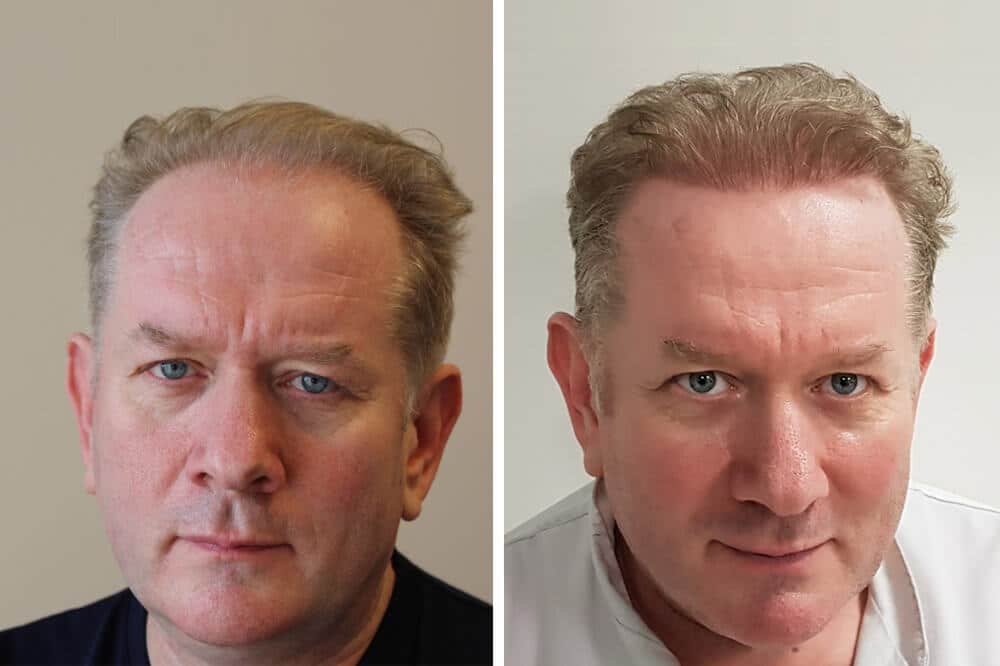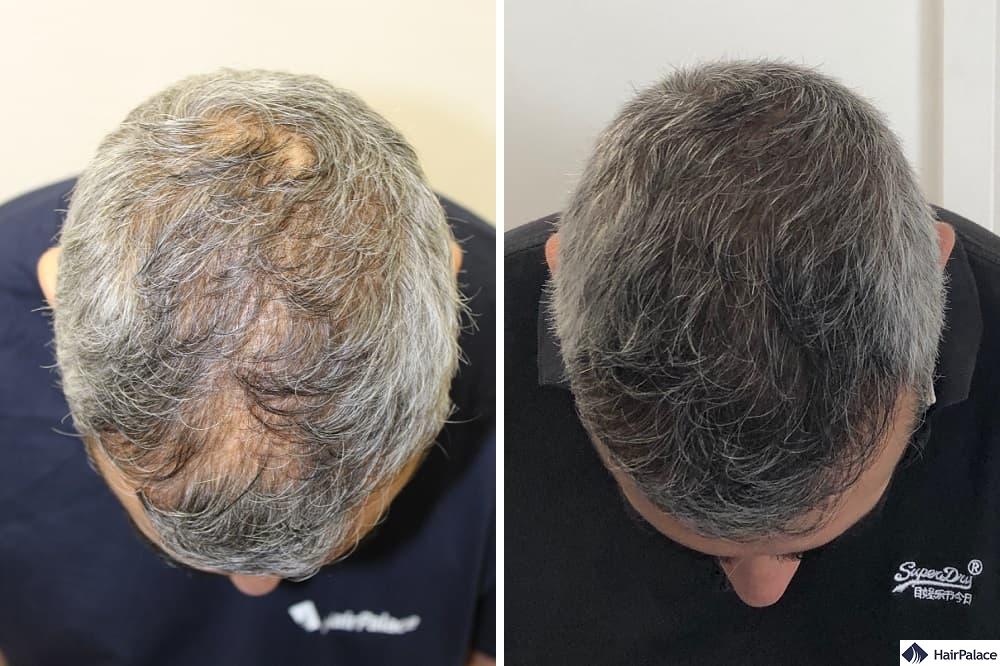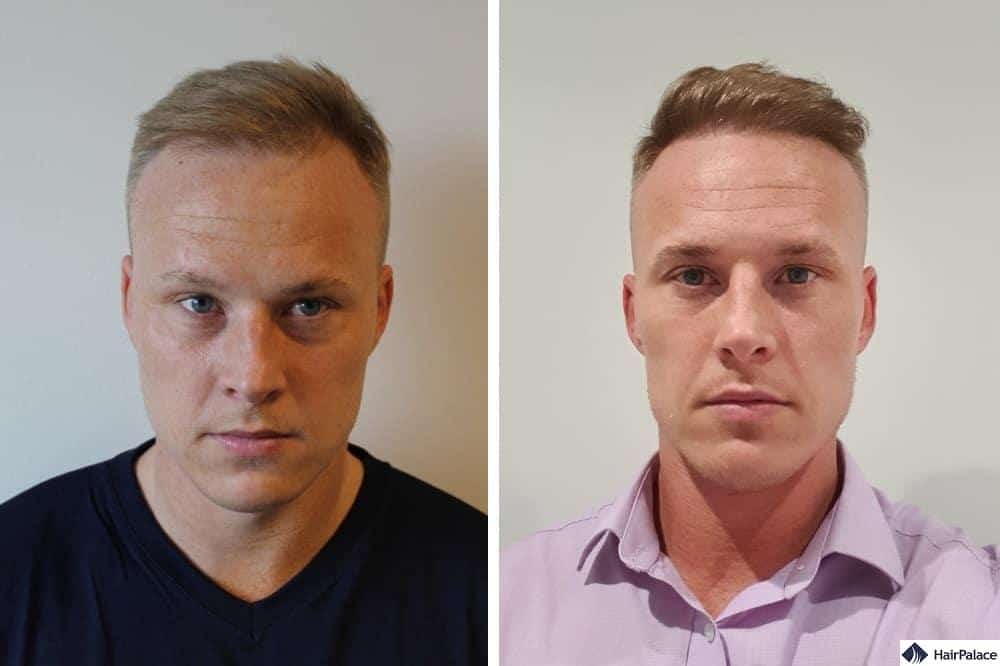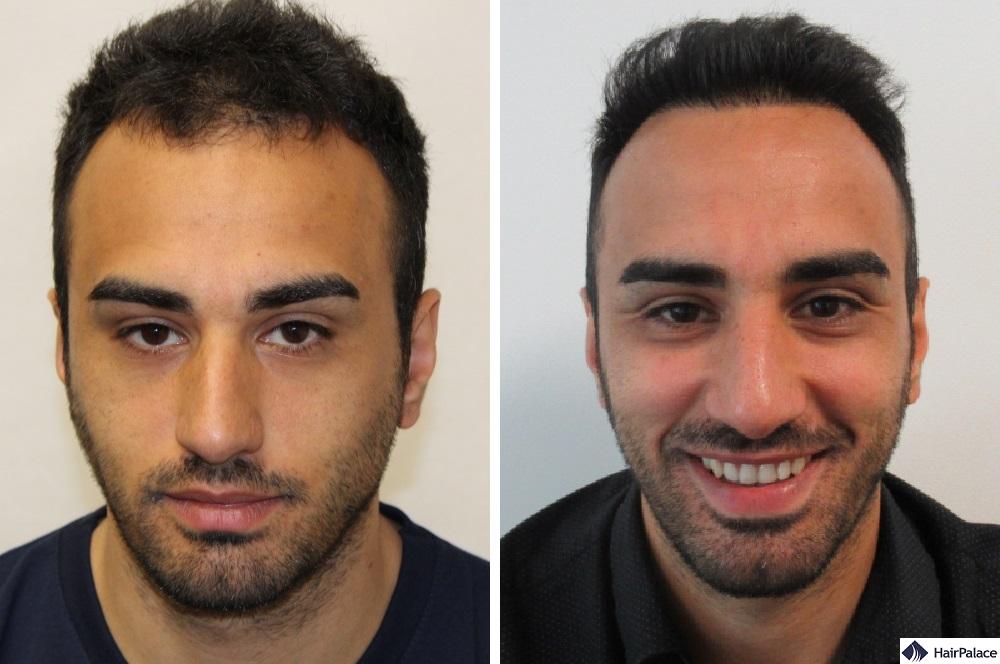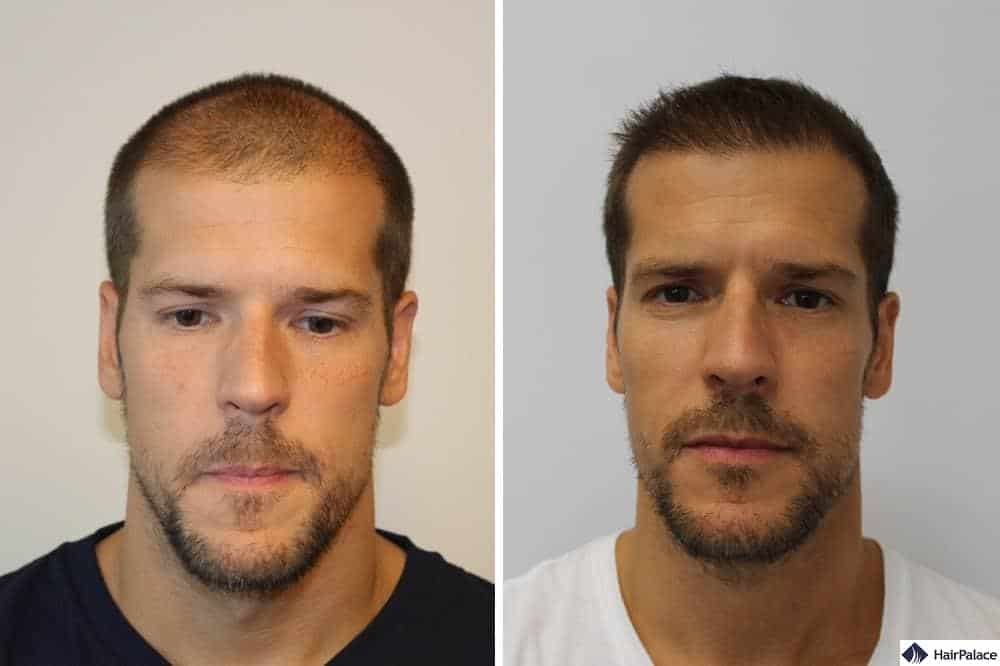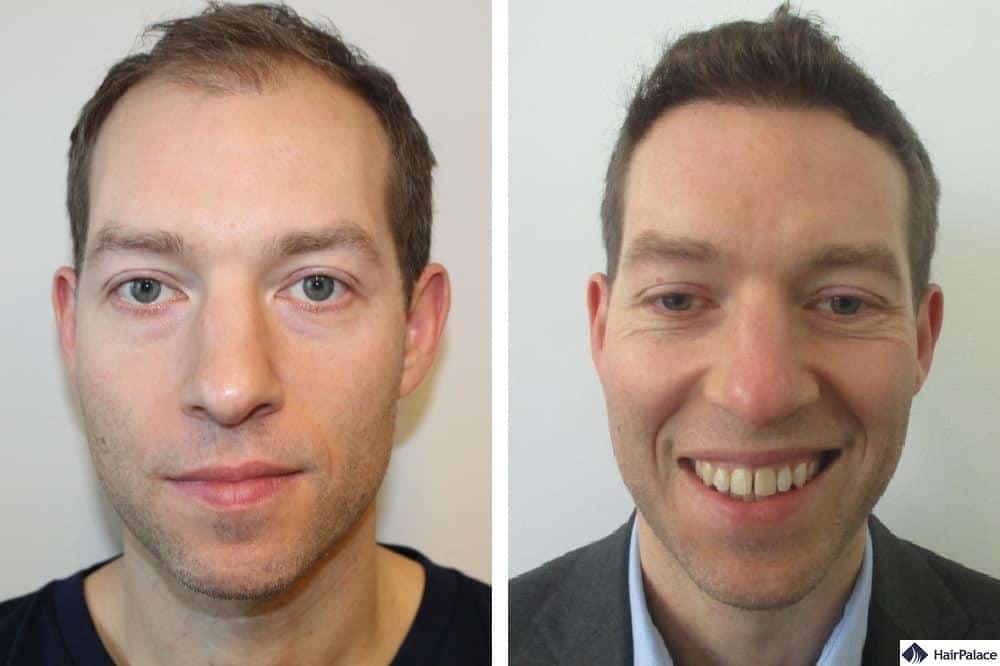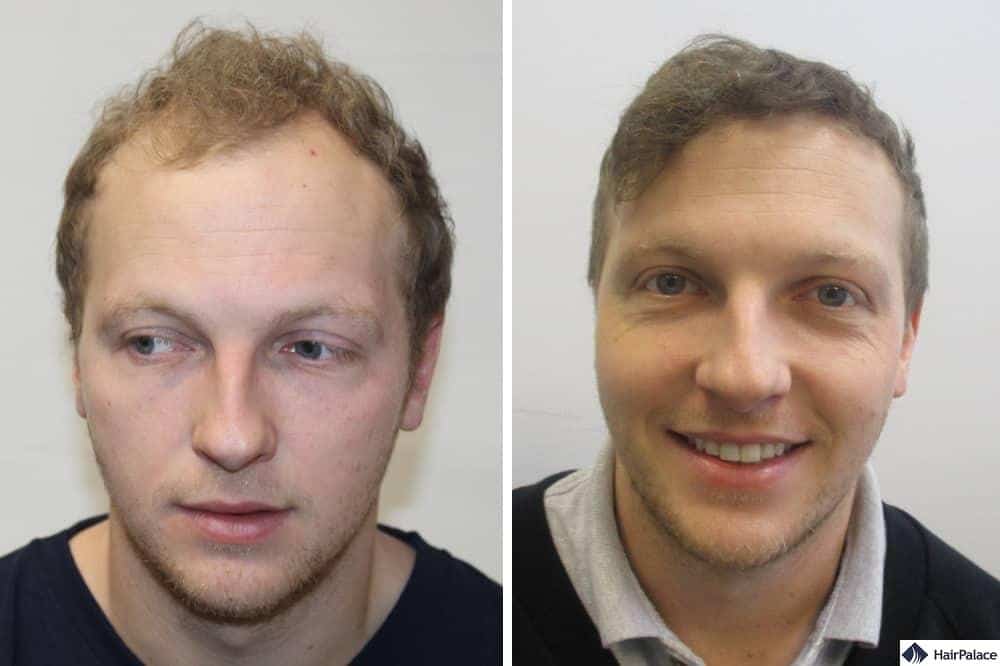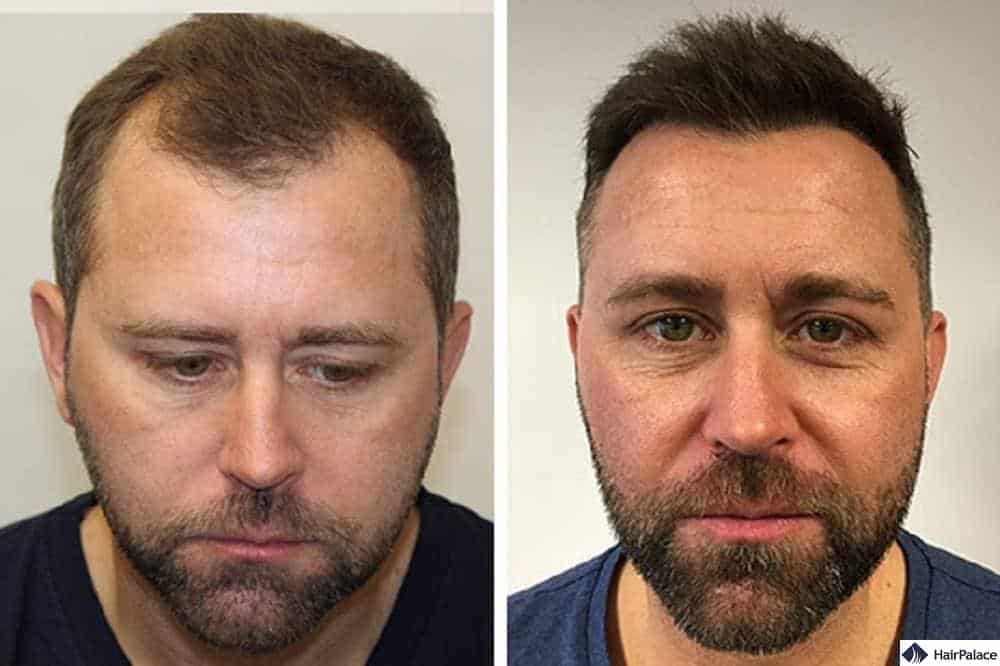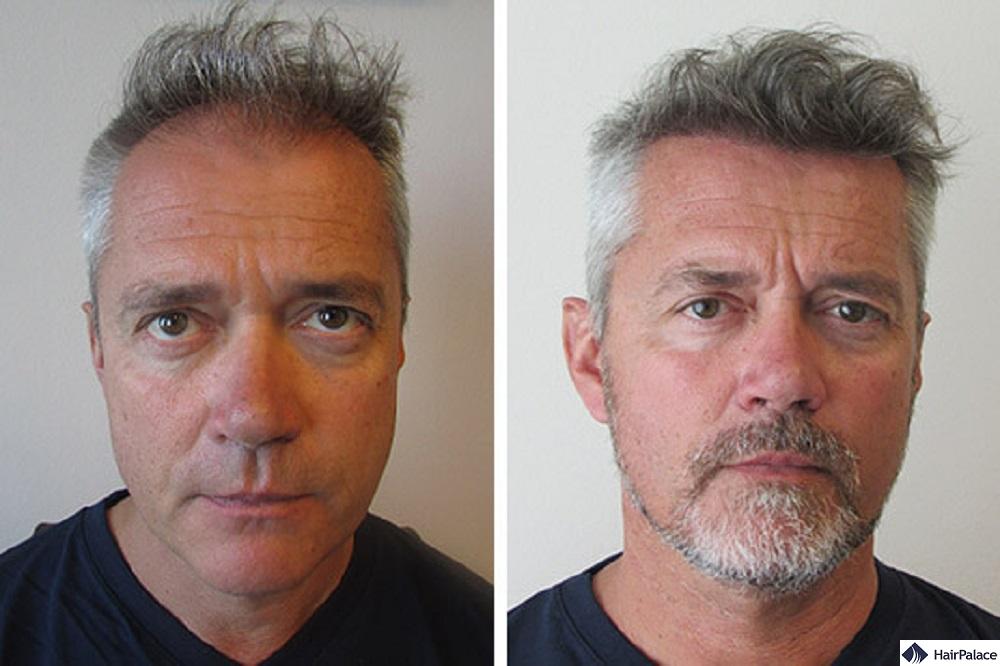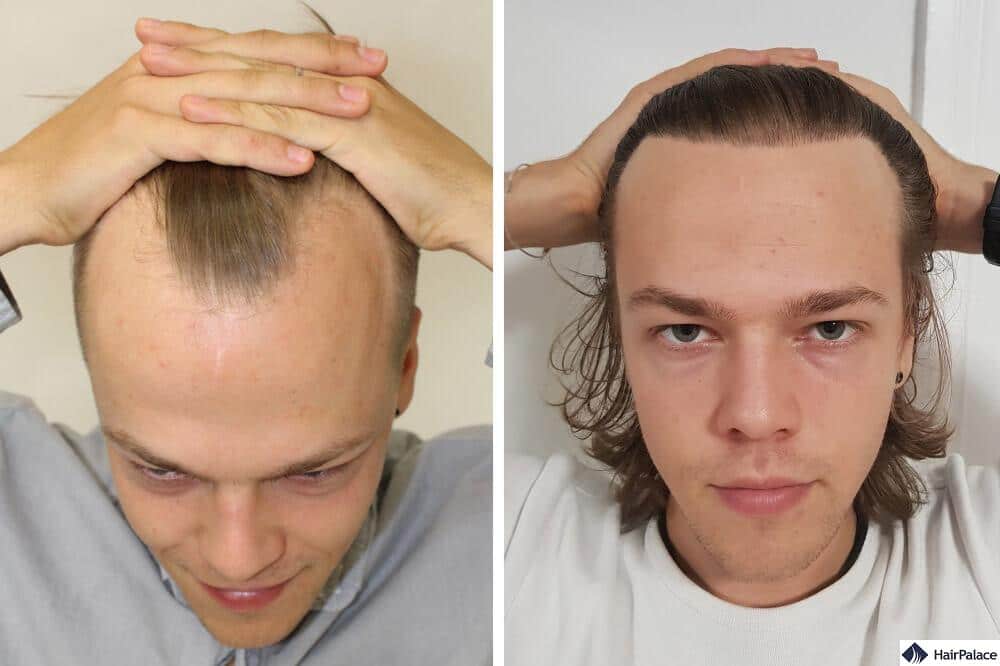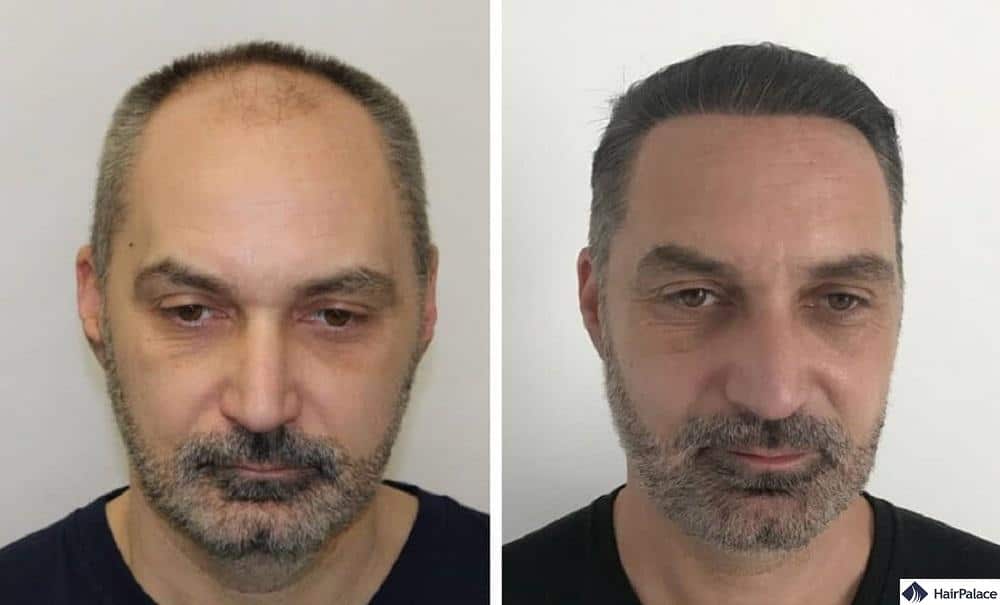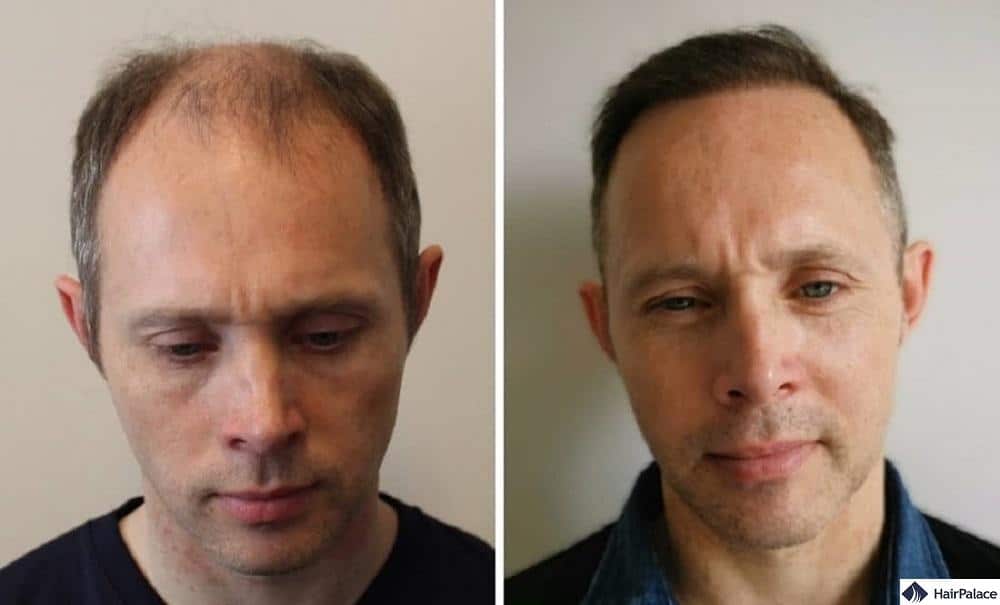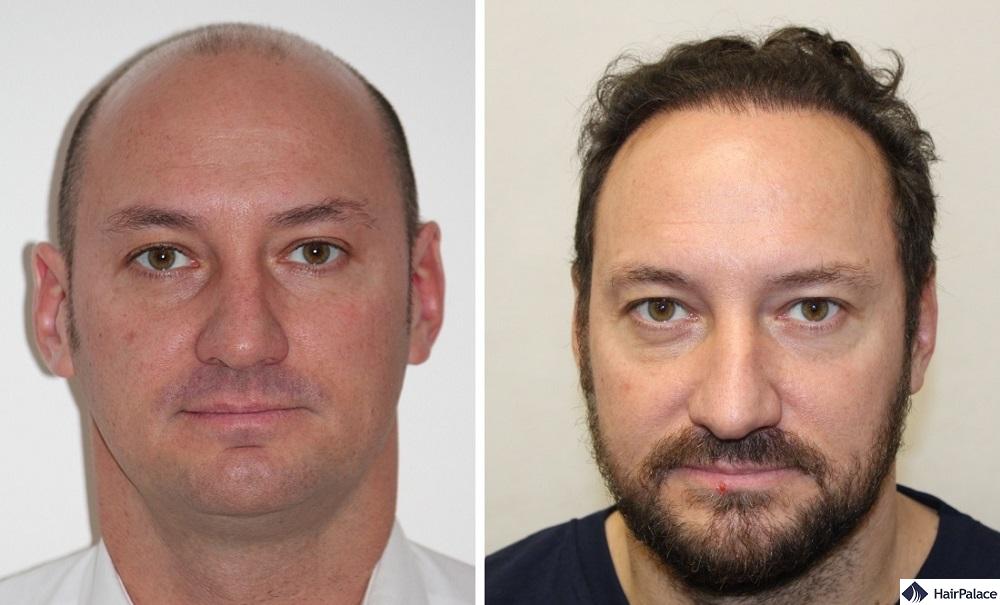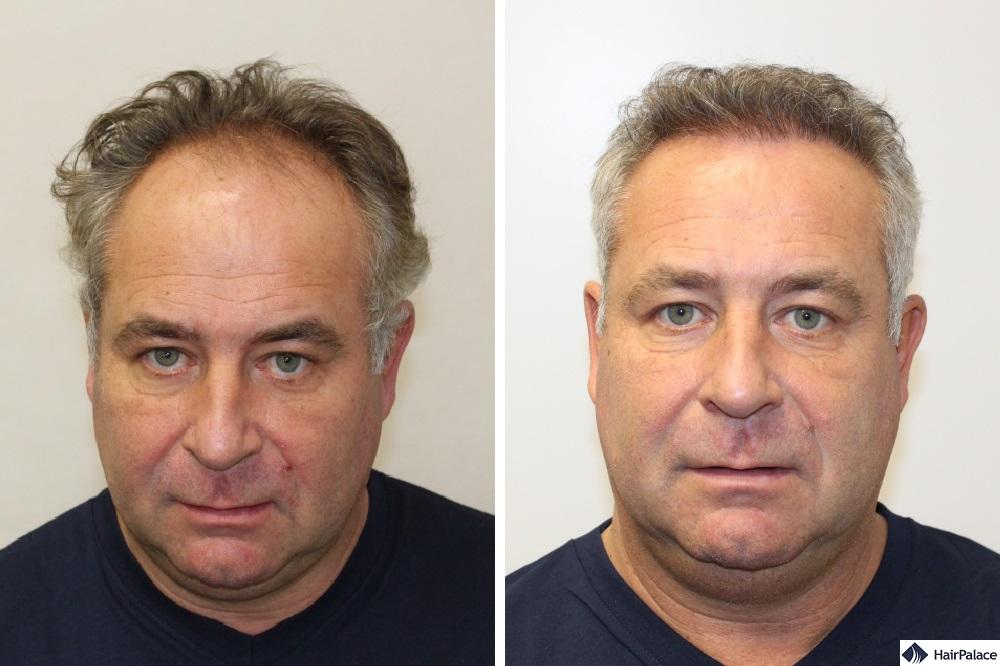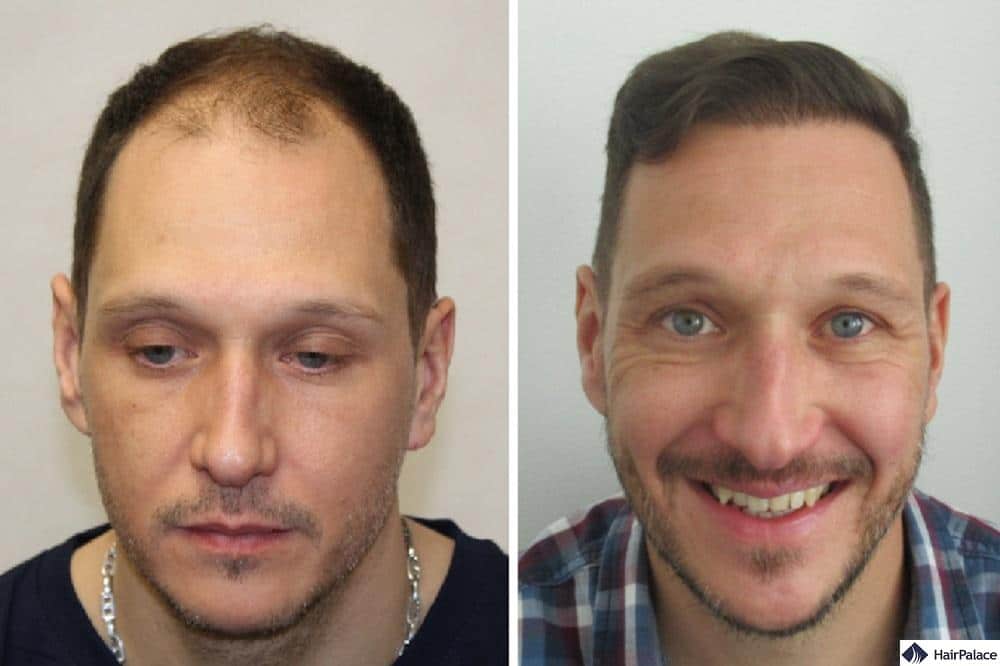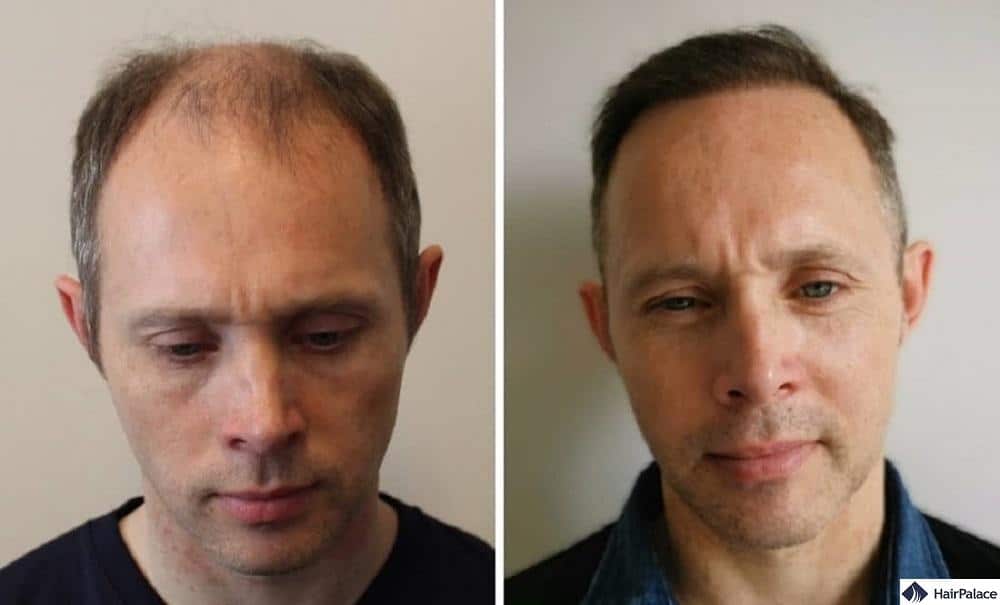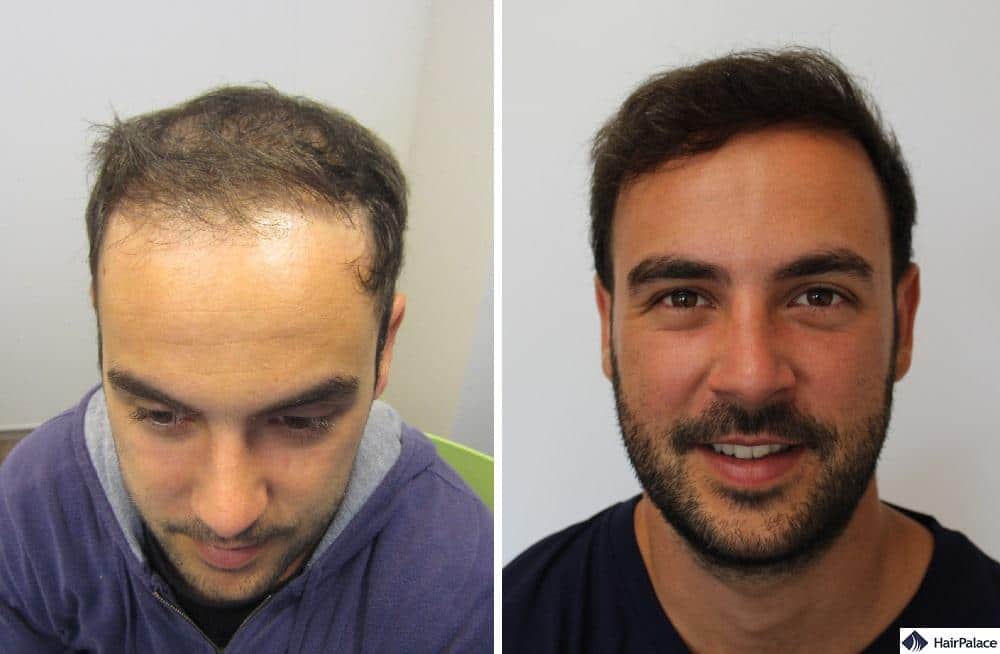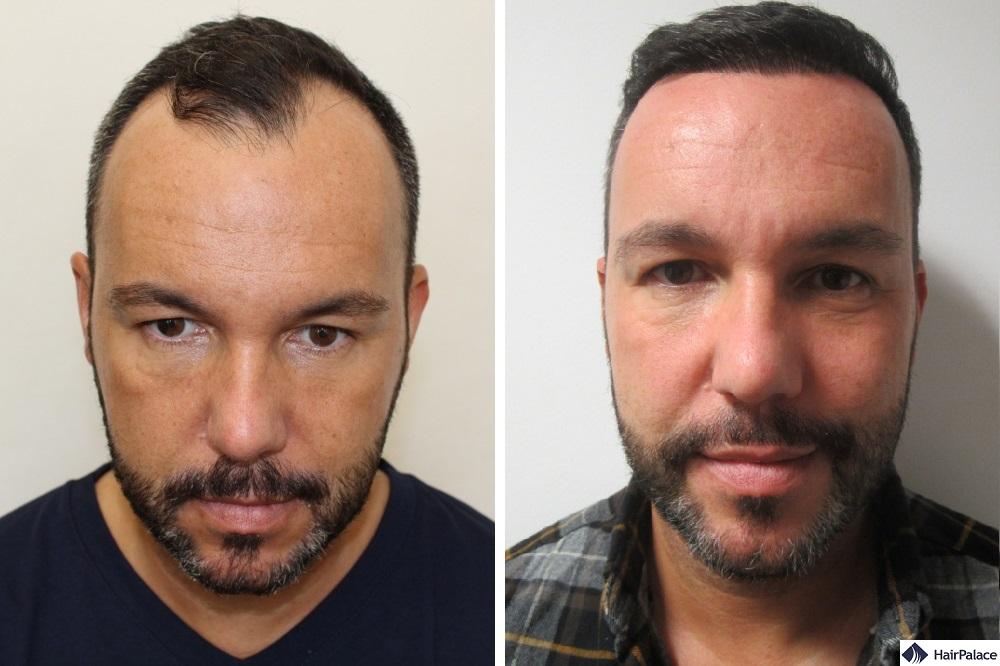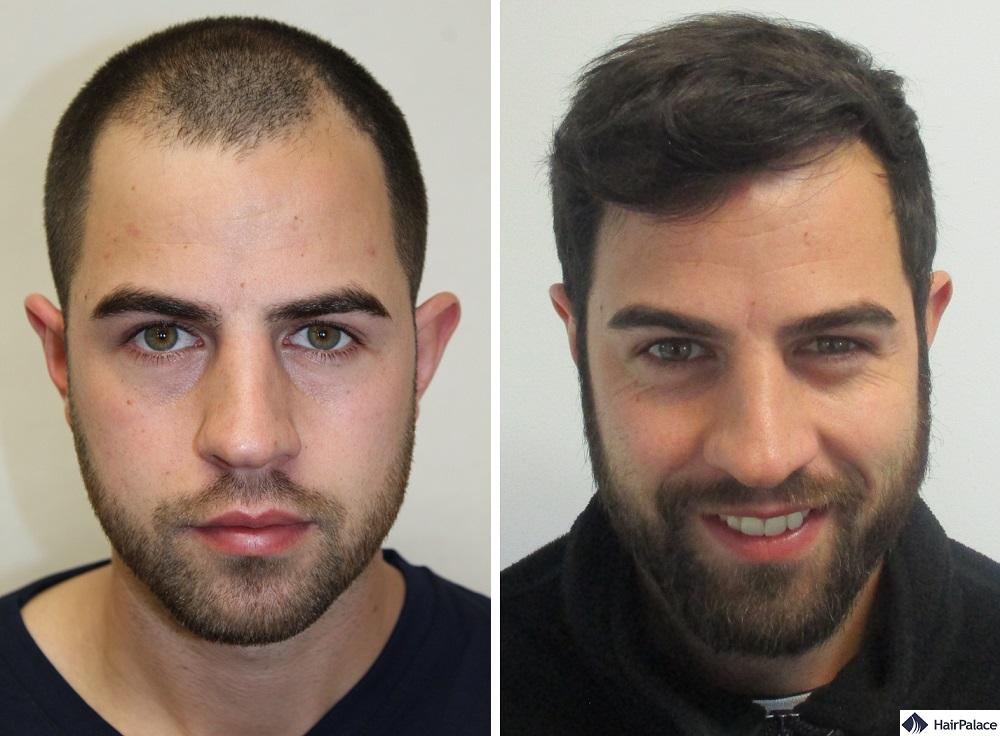Hair Transplant
Everything You Need to Know in 2025
- Fast facts
- What is it?
- Does it work?
- Prices
- Who is it for?
- How does it work?
- Recovery
- How to prepare
- Results
- Benefits
- True story
What is a hair transplant?
During the surgery, the surgeons transfer the hair follicles from the back or the side of your head to the balding area.
These procedures are typically performed in local anaesthesia and take several hours, depending on the size of the thinning areas to be covered.
It is a popular solution for patients affected by a receding hairline, balding crown, or male pattern baldness. This treatment can restore growth with natural, seamless results.
Fast facts
| Hair transplant UK | |
|---|---|
| Number of patients in 2022 | 17,000 |
| Most clinics in | London |
| Average cost | £2000-15,000 |
| Average size of surgery | 2500 grafts |
| Procedure | |
| Most popular technique | FUE |
| Duration of surgery | typically 6 to 8 hours |
| Anaesthesia | local anaesthesia |
| Shaving | required to 1mm |
| Pain levels | none to slight |
| Common side effects | temporary swelling, redness, scabbing |
| Scarring | practically invisible |
| Aftercare & results | |
| Recovery | 7-14 days (depending on method) |
| Return to work | 2-5 days |
| Exercise | from 3-4 weeks post-op |
| Hair wash | gently from 2 weeks |
| Final result | 12-15 months post-op |
Does hair transplant work?
Yes, hair transplants do work, and they can restore your hair with permanent results.
Follicles growing at the back are not sensitive to the DHT hormone, so they are unaffected by male hair loss.
During hair restoration surgeries, these follicles are moved to the bald or thinning areas to improve the density.
As they will remain resistant to DHT, they will continue to grow naturally.
Modern techniques available today also minimize trauma to the scalp and grafts, leading to success rates of 90-95%.
How much does it cost?
The cost of your hair transplant surgery will vary based on several different factors. The main one is the number of hair needed to carry out the surgery.
How much is hair transplant UK?
According to the NHS, the FUE hair transplant costs begins at £2000 and may go as high as £15000 in the UK.
However, this can vary based on the method you choose, the location and reputation of your clinic, and the extent of the procedure.
| Clinic name | 5000 hairs price (2500 grafts) | Google reviews |
|---|---|---|
| 1. London Clinic | £ 8500 | 4.9 
267 reviews |
| 2. Wimpole Clinic | £ 7000 | 4.9 
122 reviews |
| 3. The Hair Doctor | £ 7500 | 4.8 
134 reviews |
| 4. The Kensington Hair Clinic | £ 8000 | 4.9 51 reviews |
| 5. Harley Street Hair Clinic | £ 9000 | 4.3 
63 reviews |
| 6. Farjo Hair Institute | £ 8500 | 4.4 
32 reviews |
| 7. Westminster Medical Group | £ 7400 | 5.0 
23 reviews |
| 8. The Maitland Clinic | £ 12500 | 4.6 
12 reviews |
| 9. The Private Clinic | £ 12500 | 4.1 
199 reviews |
| 10. DHI Medical Group | £ 11000 | 4.2 
59 reviews |
Cheapest hair transplant UK
Even the cheapest hair transplant in the UK can cost you up to £8000, or at least around £3000 for a small intervention.
HairPalace in Budapest offers a far more affordable package for £2290, allowing you to save up to 70% on your procedure.
Every year, thousands of patients choose to travel to Hungary for their procedures.
With travel costs being roughly £100 these patients save thousands of pounds (around £5000 on average) while receiving the same high-quality treatment they would get in the UK.
Who is a good candidate?
Hair surgeries offer truly transformative, confidence-boosting results for patients of all ages:
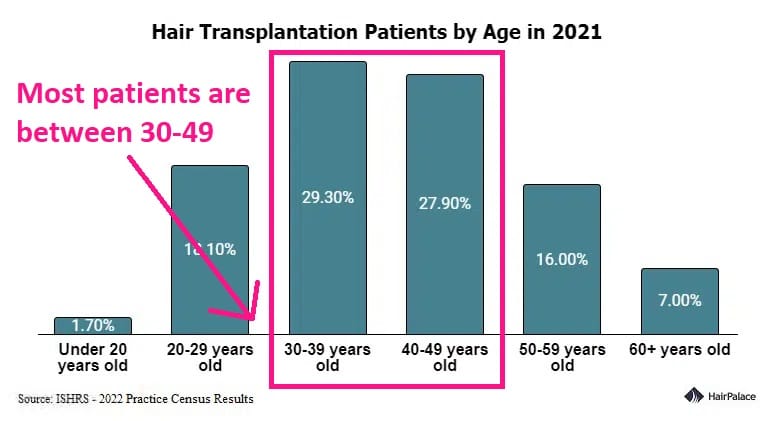
Instead of your age, your medical history and the characteristics of your hair loss will determine if the surgery is the right solution for you.
In general, you may be an ideal candidate for the procedure if:
- Your hair loss reached at least Stage 2 on the Norwood Scale
- You have been experiencing hair loss for more than 3 years
- Your hair loss pattern has stabilised
- Your hair at the back and sides of the head is dense enough to allow the extraction
How does a hair transplant work?
Mens hair transplant is a minor surgery carried out under local anaesthetic and is considered minimally invasive.
The surgeries usually take 6-8 hours to complete, depending on how many hairs you need to achieve the best hair transplant results.
Typically, patients have 2000-3000 grafts implanted in a single session. In case your hair loss continues to progress, you might need a follow-up hair replacement surgery.
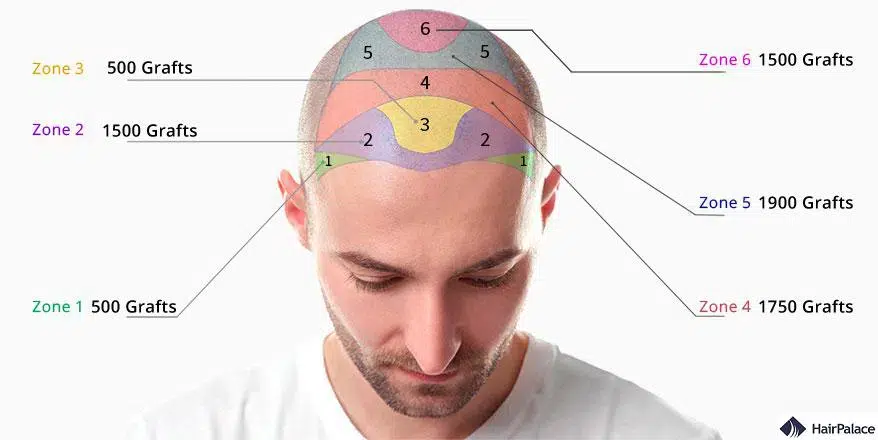
The smallest hair transplant hairline surgery usually involves zone 1 alone, which is the area of your temples.
Zone 2 covers most of the frontal region with the exception of your widow’s peak, that area is referred to as zone 3.
Zone 4 is practically a thick belt on the middle region of your scalp whereas zone 5 covers most of the crown area.
Lastly, zone 6 covers the vertex and the back of your scalp. The exact area that will be covered by the surgery will always be determined during your initial consultation.
Hair transplant consultation
While clinics have different policies your consultation at Hairpalace will consist of two main parts.
Pre-consultation screening
Once you’ve gotten in contact with one of our friendly colleagues they will ask some questions regarding your hair loss history and discuss your goals.
Our coordinators have more than 5 years of experience and they are in day-to-day contact with our surgeons.
The high level of experience and knowledge ensures that you’ll receive the best possible level of care.
If they deem you ideal for the surgery we will book you for a consultation with one of our surgeons.
Surgeon Consultation
Ahead of your hair transplant consultation, you will be asked to provide pictures from multiple angles so our experts can assess your condition.
Once the actual process begins you will have a chance to ask any questions you may have and get all the necessary information ahead of your procedure.
We advise you to prepare a list of questions in advance and make sure you walk away with the answers in hand.
The surgeon attending the consultation will also be the one carrying out your hair transplant surgery.
Finally, our surgeon will create a detailed treatment plan for you with an exact quote based on your goals and current condition.
How is hair transplant done
Here is what you can expect on the day of your hair loss surgery:
- Your hair will be cut short so the surgeon can see everything precisely.
- The surgical sites will be cleaned and disinfected.
- The surgeon will administer local anaesthesia to numb the donor area.
- The hair follicles will be removed from the back and sides of the head.
- The assistants will clean the follicles and prepare them for implantation.
- The surgeon will numb the top of the scalp. Then, they prepare the tiny incisions on the recipient area.
- Then, they will implant the new follicles.
- The surgeon will clean the surgical sites again and put a bandage on the donor area.
Once the hair transplant procedure is finished and you’re all bandaged up you will return to your accommodation.
It’s important to go easy on yourself and get as much rest as you can after the hair transplantation.
What is the most effective hair transplant method?
FUE method hair transplant
Follicular Unit Extraction (FUE) is a modern technique where surgeons extract individual hair follicles directly from either the back or sides of the head. This is achieved with the help of a special micro punch tool using tiny, round punches.
These extracted follicles are then meticulously implanted into the balding or thinning areas of the scalp.
FUE is favoured for its minimal scarring, reduced recovery time, and natural-looking results, compared to older hair transplant methods.
DHI hair transplant method
Direct Hair Implantation (DHI) extracts hairs one by one from the donor area and then directly implants them into the balding areas using a specialized tool called a Choi pen.
This technique offers precise control over the depth, direction, and angle of implantation, which helps in achieving natural looking results.
DHI typically results in less bleeding and trauma to the area, a quicker recovery time, and can be more effective in covering smaller areas with higher accuracy.
Hair surgery method at HairPalace
HairPalace uses the latest FUE2 safe system, which enhances graft survival and leads to zero visible scarring.
Our experts have nearly 10 years of experience in the field of hair restoration for men and carry out FUE surgeries exclusively.
You can rest assured that you’re in safe hands, our clinic specialises in treating male hair loss and we only employ the most qualified surgeons in the country.
Does a hair transplant hurt?
Hair transplants typically involve some discomfort, but pain is usually minimal and well-managed with local anaesthesia and post-procedure pain relief medications.
How long does hair transplant take?
The duration of a hair transplant procedure can vary depending on the extent of the transplant and the technique used, but it generally takes between 4 to 8 hours. However, more extensive procedures may take longer.
Recovery process after the surgery
Recovery after your hair transplant will be quick.
As these are minimally invasive, outpatient procedures, you can return home on the same day or the day after.
While each clinic has slightly different aftercare instructions, your recovery after the surgery will likely go as follows:
- Day 0: Remove bandages before you go to bed.
- Day 1: Start using saline spray.
- Day 2-4: Return to work.
- Day 7: Wash your hair gently.
- Day 14: Scalp must be free of scabs.
- After 3 weeks: Implanted hairs start to shed.
- After 3 months: New growth starts.
- After 6 months: Visible improvement in the density.
- After 12-15 months: Result is complete.
Hair transplant donor area recovery
The donor area in a hair transplant, usually the back or sides of the scalp, typically recovers within a few weeks.
Post-procedure, this area can experience some soreness, tightness, and temporary numbness. Small scabs may form around extraction sites but usually heal and fall off within 7-10 days.
How to sleep after hair transplant
After undergoing a hair transplant, it’s essential to adjust your sleeping position to protect the newly transplanted grafts and optimize the healing process.
For the initial days post-surgery, patients should sleep with their heads elevated at a 45-degree angle to minimize swelling.
This can be achieved using multiple pillows or a specialized wedge pillow. It’s recommended to sleep on one’s back to prevent any accidental pressure or friction on the grafts.
Using a soft pillowcase, such as one made of silk or satin, can further reduce the risk of disturbing the grafts. Additionally, it’s crucial to follow the surgeon’s post-operative care instructions.
These often include keeping the transplant area clean and avoiding direct contact with the pillow to ensure the best possible results.
How long does hair transplant take to grow
A hair transplant’s growth timeline varies among individuals, but there’s a general pattern most patients experience.
After the procedure, the transplanted hairs typically shed within 2-6 weeks, making way for new growth. By the third month, patients may start noticing some fine hair growth.
Significant regrowth is usually evident between 6 to 9 months post-transplant. By the 12th month, most patients will see about 80% of the transplanted hair growth.
However, it can take up to 18 months for some individuals to witness the full, mature results of the transplant, as the hair continues to thicken and blend with surrounding hair.
Hair transplant before and after
Your hair should keep growing as normal following an implantation. But the density of the hair can differ due to:
- The quality of the hair
- The hair’s shape (e.g., wavy, curly)
- The looseness of the skin on the scalp (scalp laxity)
- The number of follicles in the treatment area
Check out some of our stunning hair transplant before and after pictures below:
Follow-Up consultation
Thanks to our highly skilled staff, there is no need for an in-person follow-up visit to our clinic. All you have to do is provide us with quality pictures and our experts will analyze your hair transplant progress at each stage of the recovery.
Complications are rare, but in case something were to happen our experts will immediately provide you with advice and resolve the issue in its earliest stages.
One common concern of patients is hair falling out after surgery, which is referred to as shock loss.
This often scares patients but there is nothing to worry about, this is a perfectly normal part of the recovery process.
If you adhere to our hair transplant aftercare routine you’re almost guaranteed to achieve long-lasting, natural results.
Modern hair transplant surgery is so successful that your hair transplant after 10 years will look just like it did at the end of the first year.
How to prepare for a hair transplant
When it comes to a hair transplant men, the procedure requires little to no preparation on your part. However, there are certain things you can do to ensure your body is ready for the procedure.
It is important to cut back on both smoking and alcohol consumption for at least three days prior to your surgery.
It’s also best not to take any blood thinning medication, dietary supplements or vitamins for 2 weeks leading up to your procedure.
Lastly, you should have a light breakfast on the day of your operation. However, it’s important to skip your morning coffee or energy drink as caffeine can have a negative effect on your transplanted hair.
Everything you need to know before the surgery
Listen to renowned plastic surgeon, Dr. Gary Linkov explaining the most important things you must be aware of ahead of your procedure.
Benefits of FUE hair transplant
- Aesthetic change
By far the biggest advantage of a hair transplant is the aesthetic change patients experience. These procedures can help you regain your youthful appearance and self-esteem. - Increased confidence
Feeling good about your appearance will improve your self-esteem and increase your confidence. You can see this transformation on our hair transplant before and after pictures! - Natural look
During the surgery uses your own hair, so the result will look and feel natural. During the implantation, the surgeon will mimic the natural pattern and density of your hair to achieve full, seamless result. - Permanent result
Hair implants provide life-long results. The transplanted follicles will not be affected by hormones causing male pattern baldness, and will continue to grow in their new place. - Cost effective
The hair restoration surgery is a one-time expense for a lasting change. While alternative hair loss treatments are cheaper, they will remain a recurring expense, potentially for years. - Simple, low-risk procedure
Modern techniques allow you to restore the density of your hair in a 1-day surgery. While success rates are high, these minimally invasive procedures have low risk of complications, and mainly temporary side effects.
Hair transplant at HairPalace – Dean’s experience
Listen to Dean and find out how he achieved the best hair transplant results at our clinic.
Hair transplant after 10 years
Ten years after a hair transplant, the transplanted hair generally continues to grow naturally and maintain its appearance, as these hairs are resistant to the hormones that cause balding.
However, the original hair in surrounding areas may continue to thin or recede, potentially necessitating further medical treatment or another hair transplant surgery.
Overall, the long-term results depend on individual factors like hair quality, age, and ongoing hair loss progression.
How long does hair transplant last?
The first thing that patients ask themselves is does a hair transplant last forever? The short answer is yes it does.
The implanted hair follicles are resistant to the DHT hormone that causes hair loss at the top of the scalp. This means that your transplanted hair will never fall out.
FAQ
A hair transplant is typically permanent. The transplanted hairs, taken from areas resistant to balding, usually retain this resistance once moved. However, the patient’s original hair in the treated area may continue to thin over time. Regular maintenance and treatments might be needed to address further hair loss.
The initial healing after a hair transplant usually takes 10 to 14 days. However, complete healing and settling of transplanted follicles can take a few weeks to a couple of months.
Yes, a hair transplant is generally permanent, but the patient’s original hair in the treated area may continue to thin or recede over time.
Hair transplants are generally safe when performed by experienced and qualified professionals, but like any surgical procedure, they carry some risks and potential side effects.
The best age for a hair transplant is typically in one’s 30s or older when hair loss patterns are more established and predictable. However, in many cases, the hair loss stabilises earlier, or much later, so eligibility is more about the nature of your hair loss rather than your age.
Last medically reviewed on May 23rd, 2025
- ISHRS: 2025 Practice Census Resultshttps://ishrs.org/wp-content/uploads/2025/05/report-2025-ishrs-practice-census_05-12-25-final.pdf
- Kanti V, Messenger A, Dobos G, et al. Evidence-based (S3) guideline for the treatment of androgenetic alopecia in women and in men - short version. J Eur Acad Dermatol Venereol. 2018;32(1):11-22.https://doi.org/10.1111/jdv.14624
- Vogel James E et al. Hair Restoration Surgery: The State of the Art. Aesthetic Surgery Journal 2013;1:33http://dx.doi.org/10.1177/1090820X12468314
- Zito PM, Raggio BS. Hair Transplantation. Updated 2021https://www.ncbi.nlm.nih.gov/books/NBK547740/

